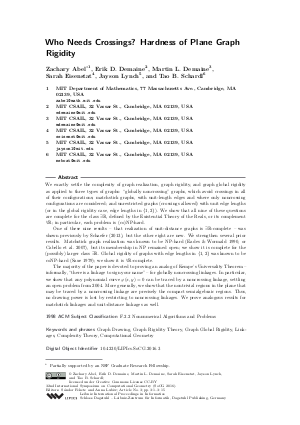Who Needs Crossings? Hardness of Plane Graph Rigidity
Authors Zachary Abel, Erik D. Demaine, Martin L. Demaine, Sarah Eisenstat, Jayson Lynch, Tao B. Schardl
-
Part of:
Volume:
32nd International Symposium on Computational Geometry (SoCG 2016)
Part of: Series: Leibniz International Proceedings in Informatics (LIPIcs)
Part of: Conference: Symposium on Computational Geometry (SoCG) - License:
 Creative Commons Attribution 3.0 Unported license
Creative Commons Attribution 3.0 Unported license
- Publication Date: 2016-06-10
File

PDF
LIPIcs.SoCG.2016.3.pdf
- Filesize: 0.66 MB
- 15 pages
Document Identifiers
Subject Classification
Keywords
- Graph Drawing
- Graph Rigidity Theory
- Graph Global Rigidity
- Linkages
- Complexity Theory
- Computational Geometry
Metrics
- Access Statistics
-
Total Accesses (updated on a weekly basis)
0Document
0Metadata
Abstract
We exactly settle the complexity of graph realization, graph rigidity, and graph global rigidity as applied to three types of graphs: "globally noncrossing" graphs, which avoid crossings in all of their configurations; matchstick graphs, with unit-length edges and where only noncrossing configurations are considered; and unrestricted graphs (crossings allowed) with unit edge lengths (or in the global rigidity case, edge lengths in {1,2}). We show that all nine of these questions are complete for the class Exists-R, defined by the Existential Theory of the Reals, or its complement Forall-R; in particular, each problem is (co)NP-hard.
One of these nine results - that realization of unit-distance graphs is Exists-R-complete - was shown previously by Schaefer (2013), but the other eight are new. We strengthen several prior results. Matchstick graph realization was known to be NP-hard (Eades & Wormald 1990, or Cabello et al. 2007), but its membership in NP remained open; we show it is complete for the (possibly) larger class Exists-R. Global rigidity of graphs with edge lengths in {1,2} was known to be coNP-hard (Saxe 1979); we show it is Forall-R-complete.
The majority of the paper is devoted to proving an analog of Kempe's Universality Theorem - informally, "there is a linkage to sign your name" - for globally noncrossing linkages. In particular, we show that any polynomial curve phi(x,y)=0 can be traced by a noncrossing linkage, settling an open problem from 2004. More generally, we show that the nontrivial regions in the plane that may be traced by a noncrossing linkage are precisely the compact semialgebraic regions. Thus, no drawing power is lost by restricting to noncrossing linkages. We prove analogous results for matchstick linkages and unit-distance linkages as well.
Cite As Get BibTex
Zachary Abel, Erik D. Demaine, Martin L. Demaine, Sarah Eisenstat, Jayson Lynch, and Tao B. Schardl. Who Needs Crossings? Hardness of Plane Graph Rigidity. In 32nd International Symposium on Computational Geometry (SoCG 2016). Leibniz International Proceedings in Informatics (LIPIcs), Volume 51, pp. 3:1-3:15, Schloss Dagstuhl – Leibniz-Zentrum für Informatik (2016)
https://doi.org/10.4230/LIPIcs.SoCG.2016.3
BibTex
@InProceedings{abel_et_al:LIPIcs.SoCG.2016.3,
author = {Abel, Zachary and Demaine, Erik D. and Demaine, Martin L. and Eisenstat, Sarah and Lynch, Jayson and Schardl, Tao B.},
title = {{Who Needs Crossings? Hardness of Plane Graph Rigidity}},
booktitle = {32nd International Symposium on Computational Geometry (SoCG 2016)},
pages = {3:1--3:15},
series = {Leibniz International Proceedings in Informatics (LIPIcs)},
ISBN = {978-3-95977-009-5},
ISSN = {1868-8969},
year = {2016},
volume = {51},
editor = {Fekete, S\'{a}ndor and Lubiw, Anna},
publisher = {Schloss Dagstuhl -- Leibniz-Zentrum f{\"u}r Informatik},
address = {Dagstuhl, Germany},
URL = {https://drops.dagstuhl.de/entities/document/10.4230/LIPIcs.SoCG.2016.3},
URN = {urn:nbn:de:0030-drops-58951},
doi = {10.4230/LIPIcs.SoCG.2016.3},
annote = {Keywords: Graph Drawing, Graph Rigidity Theory, Graph Global Rigidity, Linkages, Complexity Theory, Computational Geometry}
}
Author Details
References
- Timothy Good Abbott. Generalizations of Kempe’s Universality Theorem. Master’s thesis, Massachusetts Institute of Technology, June 2008. Joint work with Reid W. Barton and Erik D. Demaine. URL: http://web.mit.edu/tabbott/www/papers/mthesis.pdf.
-
Kenneth Appel and Wolfgang Haken. Every planar map is four colorable, Part I: Discharging. Illinois Journal of Mathematics, 21:429-490, 1977.

-
Sergio Cabello, Erik D. Demaine, and Günter Rote. Planar embeddings of graphs with specified edge lengths. Journal of Graph Algorithms and Applications, 11(1):259-276, 2007.

- John Canny. Some algebraic and geometric computations in PSPACE. In Proceedings of the 20th Annual ACM Symposium on Theory of Computing, pages 460-469, Chicago, Illinois, May 1988. URL: http://www.acm.org/pubs/citations/proceedings/stoc/62212/p460-canny/.
-
Erik D. Demaine and Joseph O'Rourke. Geometric Folding Algorithms: Linkages, Origami, Polyhedra. Cambridge University Press, July 2007.

- Peter Eades and Nicholas C. Wormald. Fixed edge-length graph drawing is NP-hard. Discrete Applied Mathematics, 28(2):111-134, August 1990. URL: http://dx.doi.org/10.1016/0166-218X(90)90110-X.
-
D. Jordan and M. Steiner. Configuration spaces of mechanical linkages. Discrete &Computational Geometry, 22:297-315, 1999.

- Michael Kapovich and John J. Millson. Universality theorems for configuration spaces of planar linkages. Topology, 41(6):1051-1107, 2002. URL: http://arxiv.org/abs/math.AG/9803150.
-
A. B. Kempe. On a general method of describing plane curves of the n^th degree by linkwork. Proceedings of the London Mathematical Society, 7:213-216, 1876.

-
A. B. Kempe. How to Draw a Straight Line: A Lecture on Linkages. Macmillan and co., London, 1877.

-
A. B. Kempe. On the geographical problem of the four colours. American Journal of Mathematics, 2:183-200, 1879.

- Henry C. King. Planar linkages and algebraic sets. Turkish Journal of Mathematics, 23(1):33-56, 1999. URL: http://arxiv.org/abs/math.AG/9807023.
- Pascal Koiran. The complexity of local dimensions for constructible sets. Journal of Complexity, 16(1):311-323, March 2000. URL: http://dx.doi.org/10.1006/jcom.1999.0536.
- N. E. Mnev. The universality theorems on the classification problem of configuration varieties and convex polytopes varieties. In Oleg Viro and Anatoly Vershik, editors, Topology and Geometry - Rohlin Seminar, volume 1346 of Lecture Notes in Mathematics, pages 527-543. Springer, 1988. URL: http://dx.doi.org/10.1007/BFb0082792.
- Neil Robertson, Daniel Sanders, and Paul Seymour. The four-colour theorem. Journal of Combinatorial Theory, Series B, 70:2-44, 1997. URL: http://dx.doi.org/10.1006/jctb.1997.1750.
- James B. Saxe. Embeddability of weighted graphs in k-space is strongly NP-hard. In Proceedings of the 17th Annual Allerton Conference on Communication, Control, and Computing, Monticello, IL, October 1979. URL: https://www.cs.duke.edu/brd/Teaching/Bio/asmb/current/Readings3/saxe-embeddability.pdf.
- Marcus Schaefer. Realizability of graphs and linkages. In János Pach, editor, Thirty Essays on Geometric Graph Theory, chapter 23. Springer, 2013. URL: http://ovid.cs.depaul.edu/documents/realizability.pdf.
